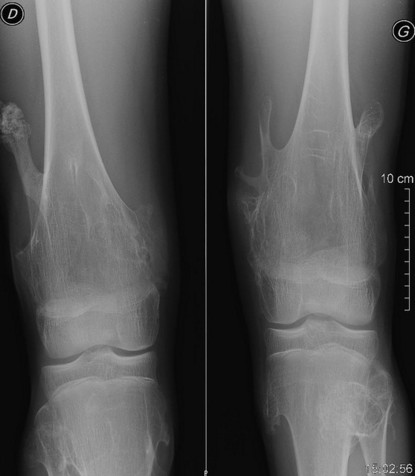MIM 133 700, 133 701, 175 450, 600 209]
(multiple osteochondromas, distorting chondrodysplasia, Bessel-Hagen disease, multiple exostoses disease)
Rare. The prevalence is estimated at 1/50,000. Autosomal dominant transmission of a mutation of the EXT1 (8q24-11), EXT2 (11p11.2) or EXT3 (19p) gene in 90 % of cases. Onset between a few months and 20 years of age. Exostoses are benign bone outgrowths surrounded by cartilage (osteochondromas). They grow and increase in size in the first decade of life and stop growing when growth plates close at puberty. Their size and number vary widely, with an number of locations averaging between 15 to 18. They usually appear at the extremities of long bones (metaphyseal area): knees, shoulders, ankles and wrists are the most frequently affected areas. The ribs, vertebrae and pelvis are less often affected. Most are asymptomatic and localized in bones that grow from the cartilage, such as the extremities of the long bones.
These hard, smooth deformities can:
- distort a limb: in case of shortening of the ulna, refer to Bessel-Hagen deformity
- be painful by compression of a nerve, a vessel or by interfering with the movements of a joint
- cause a pneumo- or hemothorax in case of costal localization
- degenerate in peripheral chondrosarcoma in 0.5-5 % of cases.

Treatment: surgical resection in case of pain or deformation; monitoring for a possible risk of degeneration.
Differential diagnosis: unique exostosis (osteochondroma), Ollier's disease, metachondromatosis, Langer-Giedion syndrome, deletion 11p11 (which causes the loss of the EXT2 gene)
Anesthetic implications:
check for any thoracic localization; multiple procedures
References :
- Codron F, Vangrunderbeek N, Florea O, Duvet S, Lamblin C.
Hémothorax spontané compliquant une maladie des exostoses multiples.
Rev Mal Respir 2008 ; 25 : 87-90.
- Chawla JK, Jackson M, Munro FR.
Spontaneous pneumothoraces in hereditary multiple exostoses.
Arch Dis Child 2013; 98: 495-6.
Updated: February 2020